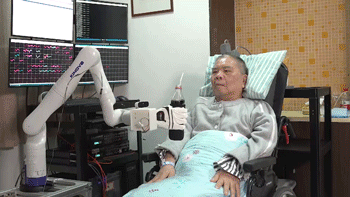
 PATIENT DRINKING BEVERAGE FROM THE BOTTLE
PATIENT DRINKING BEVERAGE FROM THE BOTTLE
Recently, SAHZU achieved remarkable results in the clinical application of implanted Brain-Computer Interface (BCI) devices. Its BCI team successfully implanted Utah Electrode Arrays in the brain of a 72-year-old quadriplegia patient who now can use his “mind power” to control a machine arm to eat, drink, shake hands and perform other major upper limb movements. The success is the first of its kind in China and indicates that SAHZU is in the leading level in BCI research internationally.
A news conference about SAHZU’s BCI research was held by Zhejiang University on Jan 16. Director of SAHZU Neurosurgery Prof. ZHANG Jianmin, Prof. WANG Yueming and Prof. ZHENG Xiaoxiang from Zhejiang University Qiushi Academy, and other members of the team attended the conference.
“Hold it! Move it closer to your mouth! Almost! There you go!” As the patient was finally able to drink beverage from the bottle held in a machine hand, everyone around him applauded. “How fascinating! It once was an impossible mission for a quadriplegia patient to drink beverage without another people’s help. But now he did it! With BCI devices!” said Prof. ZHANG Jianmin who witnessed the miracle with so much joy.
A Brain-Computer Interface is a direct communication pathway between a human brain and an external prosthetic limb. As long as the cerebral cortex is intact, the pathway can transmit brain signals which then can be decoded and command the external device even when the spinal cord and motor neural pathway are impaired.
The volunteer patient in this experiment is Mr. ZHANG, a 72-year-old retired teacher and school principal whose cervical cord was severely injured in a car accident two years ago. Although being a quadriplegia patient, Mr. ZHANG still wishes to improve his life quality with modern technology.
After approved by Mr. ZHANG and his family and the SAHZU ethnic review committee, SAHZU neurosurgeon implanted Utah electrode arrays in Mr. ZHANG’s cerebral cortex, the part that controls right upper limb, in August 2019. This surgery was the first of its kind in China.
Since the surgery, Mr. ZHANG has been studying how to “talk” to the machine arm with his “mind power”. Every day, Mr. Zhang has to practice, from controlling mouse clicks on computer to commanding the machine arm for three-dimensional movements. To grasp, to hold and to move things are simplest movements for regular people but actually are a series of complicated processes including sending, transmitting and decoding signals. What would have been impossible for patients suffering from spine injuries and body function impairment like Mr. ZHANG, are now being realized by BCI technology.
72-year-old Mr. ZHANG is not the first BCI implanted patient but the oldest using BCI to reconstruct his body’s movement function in the whole world. Compared to other patients who are mostly in their young or middle age, Mr. ZHANG is inferior in his body strength, concentration and coordination because of his age. It makes the experiment more difficult and the success more precious.
About 20~30 million Chinese people are suffering from paralysis caused by brain stroke or brain or spine injuries. BCI can bring hope to these people and improve their life quality. It is hoped that the clinical application of the interface can be expanded from movement function reconstruction to the repair of language, sensory, or recognitive motor function and other more complicated functions.
“The ultimate goal of basic research is to solve practical problems for patients.” said Prof. ZHANG Jianmin. “Brain stroke is common in elder people. Some patients survived but had complications such as hemiplegia or aphasia. Therefore, this experiment on Mr. ZHANG will have its special meaning for future clinical treatment and rehabilitation for elder patients.”
Author: | Reviewer: | Editor: | Source: | Date:2020-01-20 | Views:![]()
![]()